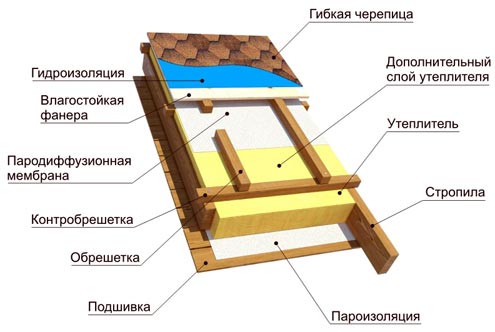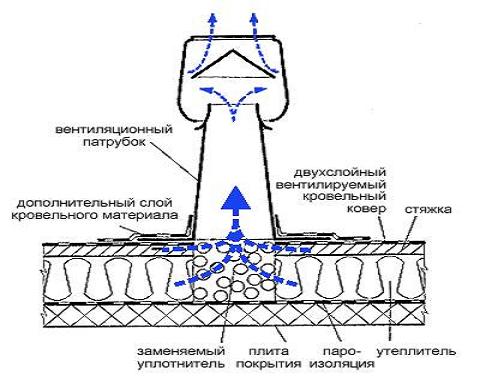The house under the roofing of soft tiles looks like a special cozy and elegant. Flexible roof attracts many developers with its available cost, simplicity of installation. Bituminous tile possesses good air and moisture-proof properties. Therefore, the roof ventilation is necessary.
Content
What is a flexible roof
If you look at the characteristics, then the flexible roof price is not so big, just ideal. Well, judge yourself:
- on the street rain, and in the house there is no drum fraction from falling droplets falling on the roof;
- material never prorzhaveet;
- does not rot;
- the roof is covered with fungus or moss;
- it does not need a lightning rod, since the electrical conductivity of soft tile is equal to 0;
- it is easy;
- she is not afraid of the temperature surges and strong winds;
- easy to install;
- during the operation does not require special attention;
- environmentally friendly;
- sealed at 100%;
- price is not high.
Although a flexible roof positive reviews, but here, too, his present:
- low temperature makes roof fragile, so it is necessary to install it in warmth;
- as soon as the temperature dropped to +5 degrees C, the installation work should be suspended or to use thermofen.
- the roof bias should be at least 5 degrees.
Famous manufacturers
- High-quality flexible roof is released in Finland. Lemminkainen Concern is a soft tiled kerabit. Tile is produced in three forms, has a wide color palette;
2. The Katepal Oy plant is also located in Finland and produces quality flexible KatePal (spoken), having excellent technical indicators;
3. The roof developed by Tekhnonikol is also popular - shinglas (Shinglas). There are 5 species that differ in form and sizes. This is a flexible roof price for which is quite democratic, and in addition, it is reliable and durable, since:
- resistant to ultraviolet rays;
- it does not multiply biological organisms;
- It does not affect her;
- work perfectly in the climatic conditions of Russia.
Device flexible roof
To flexible roofing well showed itself in the process of operation, it needs to be equipped correctly. The design of the roof of soft tiles can be compared with Napoleon's cake. If for example, consider, from which it consists, then it will become clear why:
- Tiles soft;
- Lining;
- Shap;
- Air circulation space;
- Diffusion membrane;
- Layer heat insulating;
- Vaporizolation.
Work on laying flexible roof
Everything is done in 7 receptions:
- The basis is prepared;
- A gap for ventilation is arranged;
- A solid carpet is sprinkled with a gasket from bitumen material in case the slope is less than 18 degrees, and if more, then in places where leaks are possible;
- Now you need to consolidate the slats from the metal in the ends of the roof and on its cornice. On top of them, lay flexible tile: Eaves:
- Next should be done by laying an end carpet using nails;
- The turn to work on the installation of Shinglas, that is, the ordinary tiles;
- The skating tile is stacked along the skate.
Okeekhet
The roof of the roof of the flexible tile is attached to the counterclaim, with which the space for ventilation is also created. The doomle carries all the layers of the roof.
Next materials need:
- edged board, better from coniferous trees;
- plywood, but not any, but a special moisture resistant or OSB-slabs, a shortened board. The greater the step of the rafter, the thickness of the material;
- galvanized nails.
Clamp requirements:
- solid - no steps and irregularities;
- jigs to customize perfectly;
- if under the roof it is not planned to arrange some kind of room, then the lamp is needed only in order to mount the flooring;
- between the elements to perform the lumen of millimeters 1-3;
- the crate to process the composition preventing the appearance of mold;
- want to attack? Be sure to need ventilation gaps.
Ventilation of the roof of flexible tile
And why, actually, do you need ventilation?
If it is not, then:
- Staying hot summer in the attic room will be impossible due to excessive temperature;
- The insulation will not be able to fully fulfill its functions, as it accumulates an excess of moisture;
- The underpants structures will affect the fungus and mold;
- In winter, the roof will cover ice, icicles will appear;
- Condensate is formed in large quantities and will begin to penetrate the ceiling;
- The coating can decide due to excessive heating in the absence of ventilation.
So that the underpants space was ventilated correctly
You must fulfill the requirements:
- the air layer is created between two layers of roof: insulation and base, by installing a minimum of 5 cm with a thickness between them;
- additionally, you need to leave the air holes on the bottom of the skate, providing the influx of fresh air. So that the birds do not sit here, provide for the installation of sofits or lattices.
- arrange holes for air hood in the form of ventilated skates or aerators;
- so that the flow of air in his movement does not interfere, in the crate must be breaking. Thus excluded stagnation;
- section of the beam, that is, the height of the air gap must be pre-calculated, linking it with the slope and slope length.
Example: For a roof having a slope of 10 degrees and a length of 5 m is enough 50 mm of air gap, and for the roof with parameters: length 25 m of power, angle of 10 degrees requires a clearance of 100 mm.
Ventilation can be one and two-door. Vividly displays a flexible roofing device. This is a two-circuit option:
- Insulated layer:
- Diffusion film;
- protection from wind;
- Ventilation space 1st;
- Clearance for ventilation 2nd;
- Coating.
Ventilate the roof and can be forced
To ventilation of flexible roof, was more efficient, use aerators. Due to the pressure difference inside and outside, air flows occur. A low pressure is created in the aerator tube, thereby appearing a traction.
They can be of different heights, differ and diameter, and their number on the roof depends on these parameters. In particular:
- when installing, it is important not to exceed the minimum distance between them - 12 m;
- select the highest points that are uniformly;
- on the new roof the best place - the joint on the insulation. Should be relying on the last layer;
- if you are repairing a soft roof, then look for the greatest bloating, there and install the aerator;
- the hole under the flugark is performed by a large diameter than it is 1 to 2 centimeters.;
- attach a aerator with dowels, anchor bolts;
- sealing by gluing waterproofing materials.
Installing aerator when repairing
Even if the highest quality roof was installed from the flexible tile price for which the highest, but at the same time, the installation works are incorrectly, the moisture under it will accumulate. Then the output will be 2:
- change the whole design;
- install aerator.
Installation order Next:
- in the right place, a hole is performed passing through the screed and roofing carpet before the insulating layer starts. This is a place for a ventilation pipe;
- it is removed in this place the wet insulation and is located dry;
- to ensure the clutch of aerator and roof, mastic is applied on its basis;
- aerator skirt is attached to the screed of self-drawing;
- the bottom of the nozzle is additionally isolated.
Aerator Koknoy
- Roofing flexible;
- Pad;
- Base;
- Shap;
- 1st timber;
- Waterproofing;
- Pig;
- Insulation;
- 2nd timber;
- Steam insulating layer;
- Wooden plank;
- Layer of binder;
- Tile;
- Roofing fan.
To avoid repairing a flexible roof, you need to correctly perform all the steps of its installation, in particular - soft tiles.
Fastening soft tiles. How to make it right?
- First: again for fastening should be solid and smooth;
- secondly: Sheets are nails;
- the rubber-bitumen mass itself is glued, as a result of heating under the sun.
Important: The length of the nail should be enough so that it passes through the crate completely, and the tip peeking. Otherwise, if the board is dry or dismissed, the nail will be released from it, the flexible tile is linked and the seam will open.




























